 |
This map is released under terms of the CC BY-SA 4.0 license. |
Area Links:
Wandering Monster Table (2d6):
2 1d4+1 fire salamanders – guests of the Palace
3-6 See the appropriate Area Table below
7 1d4 normal human servants (1-in-6 demihuman) with 1d4 snake-men Emissaries supervising
8 A lone, snake-man Noble
9 A snake-man Noble with a Myrmidon bodyguard and Emissary advisor
10 1d4+1 Minotaur guards with a Myrmidon officer patrolling or relieving other guards
11 1d4 snake-men Nobles with 1d4 Myrmidon guards, 1d4 Emissary advisors, 1d4 normal human servants
12 Khan-Ni-Tet and their entourage (see Room 21. This may be an exception to their normal schedule)
Area A
3 Lo-Khufu (possibly in human guise, see Area A, Room 6) with 1d4 Emissaries and 1d4 Myrmidons
4 1d8 guard trolls
5 1d6 guard basilisks
6 A contingent 8d6 specialist eunshiel or ennan deep fey workers (50/50 chance of either,) such as: artists, chefs, musicians, engineers, etc.
Area B
3 1d4 mummies – former Snake Cult high priests or wealthy donors “gifted” with undeath and currently visiting the Palace
4 1d4 snake-men Nobles, with the usual chance of Myrmidons, Emissaries and/or servants
5 A contingent 8d6 specialist eunshiel or ennan deep fey workers (50/50 chance of either,) such as: artists, chefs, musicians, engineers, etc.
6 1d4 giant (rock) pythons – pets that are allowed free rein in the Palace living areas.
Area C
3 1d6 oni (ogre magic-users, see Room 19; 1-in-6 chance they are polymorphed into normal human servants)
4 A marching unit of 1d10x10 baern-men (bugbears) led by a snake-man Myrmidon officer
5 1d8+1 ogres whose job is to open and close the heavy entrance gates
6 A group of Palace visitors with a snake-men Emissary leading (see Room 19)
Area D
3 A black pudding – the living waste product of the Snake God
4 An ochre jelly that has oozed out of an organic pustule in the Inner Temple
5 1d6 oni (ogre magic-users, see Room 19)
6 1d4+1 snake-men Myrmidon guards
Commentary
End of an Era
By finishing Level 6, I realize am now about two-thirds of the way through the Dungeon23 project! This also concludes the Snake Cult-related portion of the dungeon, as we depart the upper levels to delve into the mysteries of the rest of the Underworld. While Level 7 will still feature the snake-men (being their City, after all,) I envision it as more of a transition area into the last three levels.
Experience Need not Apply
As a child of the "Middle" School of RPGs (2nd Edition era,) I used to buy into the idea of dungeons being boring or at least passé, favoring "true" roleplaying adventures (restrictive, narrative railroads, really.) Things have changed a lot for me since then, but the result is that I'm not all that familiar with dungeon building past the Basic levels of 1-3. Yes, tougher monsters, deadlier traps, and more treasure then King Midas are the standard, but what else is there?
I started by considering what dungeon obstacles parties of levels 4+ can easily bypass with magic or thief abilities. Here's non-exhaustive list:
Dark places (this is why most of the True Temple has dim lighting)
- Reconnaissance, surprise, and ambush are easy with clairvoyance, invisibility, silence, and/or higher thief abilities
- Locked doors and objects are little problem thanks to knock (this is why some locked doors have no existing key locations)
- Pits, level connections without stairs, and other high places can be levitated to and from or climbed by thieves.
- Hidden treasure or traps are easy to find with find/locate spells
- Magic-using enemies' spells can be dispelled or casters silenced
- Rooms full of enemies can be cleared with fireballs, lightning bolts, and the like
- Full water areas are no issue with water breathing
My conclusion: I could pretty much go nuts with level appropriate enemies, tricks, traps, and dangers without much concern about how players will deal with them. If that's not Old School, I don't know what is!
The limits of AI
I know I've been gushing about using AI tools to help with or enhance the project, but the more I use it, the more I realize its limitations. I've been getting some samey results with ChatGPT, that don't really spark good ideas, and I've used the tool less and less.
I also painted myself into a corner in deciding to include AI art to illustrate features of the dungeon entries, and it's additional (and likely unnecessary) work. On the positive side, I've been getting some practice with editing tools like GIMP - amateurish to be sure, but check out the image of Khan-Ni-Tet. I amalgamated it from several AI images, and I'm pretty proud of it (in a please-display-my-crayola-drawing-on-the-fridge kind of way.) It begs the question: at what point does it become "true" art?
As I've mentioned before, I am aware of the controversies with AI art (it even got WotC recently,) and I am sympathetic to those that feel threatened by it, but I think that short of some landmark court case where they prove egregious copyright infringement, AI tools are likely here to stay. Professionals and companies alike will probably have to compromise at some point to remain competitive. And that is the sad, dystopian reality.
This work includes material taken from the System Reference Document 5.1 (“SRD 5.1”) by Wizards of the Coast LLC and available at https://dnd.wizards.com/resources/systems-reference-document. The SRD 5.1 is licensed under the Creative Commons Attribution 4.0 International License available at https://creativecommons.org/licenses/by/4.0/legalcode.





No comments:
Post a Comment